by Editor | Jun 11, 2012 | Products
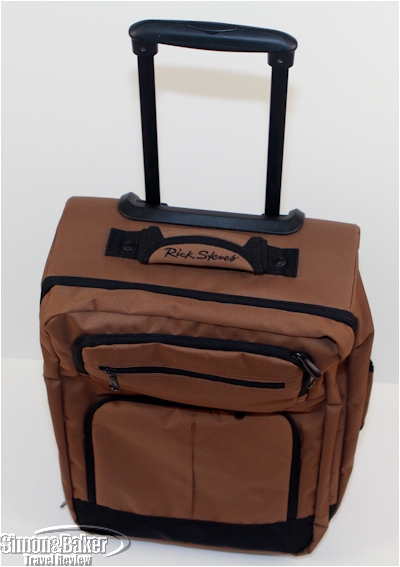
The Rick Steves rolling bag
In these days of airline luggage fees light weight high performance bags are more important than ever. We set out to test a light weight rolling carry on bag. We meant to order a regular Rick Steves carry on bag and instead ordered the new lighter weight Rolling Backpack that retails for $160. By the time we discovered the error it was too late for the first trip to Europe and we decided to try the bag since although we were not looking for a backpack it was light weight and small.
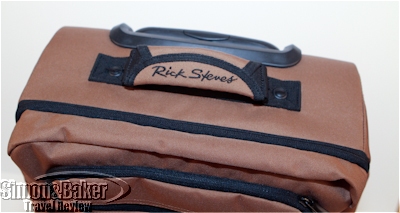
The telescoping handle enters smoothly into the recess
We were looking for a light weight carry on with wheels for an itinerary in Europe that involved multiple transfers in trains, planes and automobiles and later for a short domestic itinerary in which the carry on would be the primary luggage piece. This case with two wide-tracking wheels, 1,960 cubic-inch main compartment, telescoping handle and two outer zipper pockets was just the right size for our needs. It also had an air mesh on the back of the bag, a clip-in document pouch and zippered mesh lid compartment the length of the bag.
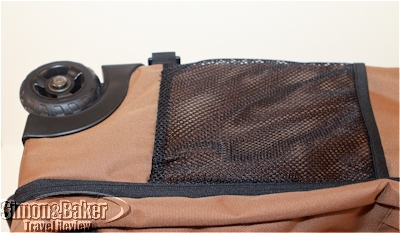
One side has a handle and the other a mesh pouch
At first it looked like the backpack bag would not remain upright but that issue disappeared once we packed some contents into it. Although we never made use of the backpack function (two straps were tucked handily in the back of the bag) the carry on case performed well on both trips. At 5.5 pounds it was light weight, easy to maneuver around train stations and airports and lift onto the carry on compartments on the planes. The 7 inch by 20 inch by 14 inch case fit easily in all travel spaces.
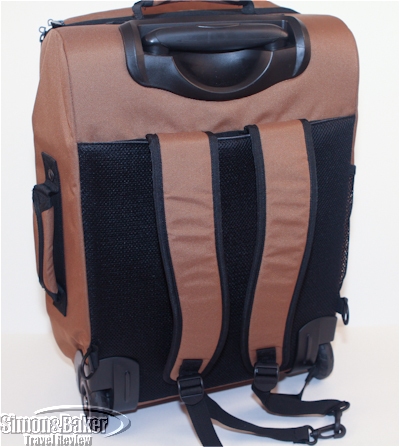
The backpack straps tuck into a pocket in the back
The recycled high density polyester fabric survived both trips without scratches or stains although it sat in the high speed train (TGV) luggage rack twice and in the airplane overhead compartments on six flights. It also got wet on several occasions and none of the contents including electronics like cameras and iPad became wet or suffered any ill effects.
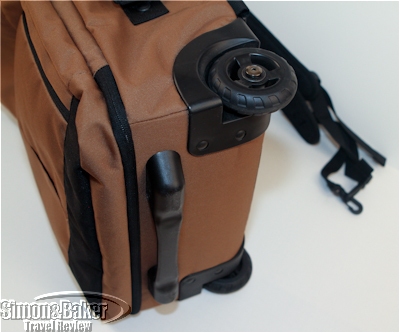
The foot in the bottom doubles as a handle
In both itineraries we were pleased with the bag. We will take it again on short domestic and longer itineraries in which traveling light of weight is a priority.
by Editor | May 29, 2012 | Products

The tarpaulin above the entrance while the Hotel de Crillion was renovated
The last time one of our teams visited the Hotel de Crillon the icon property in the Golden Triangle of Paris, France was shielded by a large tarpaulin while renovations to the historic building took place. Following a year of meticulous renovations under the supervision of Etienne Poncelet, lead architect and head inspector of Historic Monuments, the luxury property designed originally by Ange-Jacques Gabriel emerged at the end of 2011.
Once the work was completed what was the hotel to do with the 1,300 square meters of tarpaulin that covered the scaffolding during the many months of renovations? Instead of tossing the material the Hotel de Crillon teamed up with Bilum to create Recycled Bags from the Hotel de Crillon, an exclusive line of 450 made in France bags and accessories that recently became available for purchase. The line includes three designs: Pouch for 25 euros, Clouch for 35 euros and Shopping Bag for 65 euros each (plus shipping for mail orders).
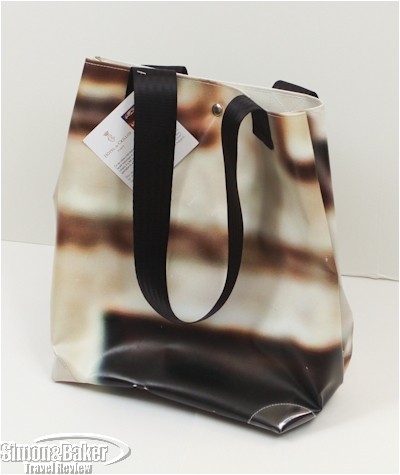
Our Shopping Bag, made in France with the discarded tarpaulin
Our Shopping Bag, 12 inches wide by 14 inches tall, has plastic reinforced corners at the bottom, two Crillon/Bilum tags, and a sales tag that identifies the bag as an original. The tag also says the bag was made in 2011 in a studio, “specialized in bagagerie and saddlery,” close to Paris.
The preparation work, carried out in Choisy-le-Roi, focused on the artistic and graphic aspects of sizing the tarpaulin into pieces fit for the line. The actual crafting of the bags and accessories took place at three specialized workshops in the Greater Paris region and the south of France. The project’s recycling, fashioning and finishing phases included the participation of a social integration and outreach program in the Greater Paris region.
The one-of-a-kind items, sold exclusively at the hotel gift shop (http://www.crillon.com/#atyourservice/theboutique, +33 44 71 1592, boutique@crillon.com), allow hotel guests and fans of the historic building to take home a piece of the Hotel de Crillon’s former tarpaulin facade while contributing 3 euros per item to the National Museum of Natural History association, which strives to preserve plant and animal biodiversity. Kudos to the hotel for its recycling efforts supported by local manufacturing and design.
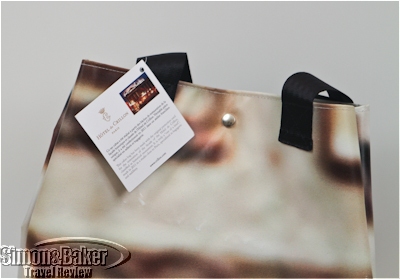
A tag explains the origin of the bag
by Editor | Jan 16, 2012 | Products
By Gary Cox
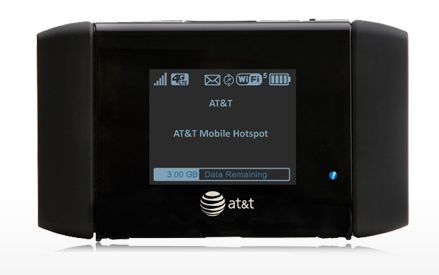
ATT Elevate 4G
We like to stay connected when we travel. Our latest gadget in this quest is the new ATT Elevate 4G, a portable WiFi hot-spot that allows up to five devices to share a single data service connection. Traveling with a laptop, iPad, Kindle and Skype phone can be a challenge even with today’s ubiquitous WiFi network access, but the Elevate can make connecting simple. The access speed on a 4G network was great, making Skype calls clear and cellphone and web browsing very usable. Enabling the Elevate for international use proved to be the biggest challenge.
The Elevate is a convenient size, and it can be charged via USB or the AC adapter. The devide supports tethered use via USB or up to five devices via a wireless connection. The microSD card that came with it is pointless, since it is only accessible via the USB connection and not to wireless clients.
The online menu provided useful feedback on ATT and roaming data usage, and access to control a handful of settings. The most critical of these is the option to connect to non-ATT networks when roaming. Failing to turn on this feature prevented it from working outside the United States as by default the modem would only connect to ATT networks. SMS messages were delivered via the menu system.
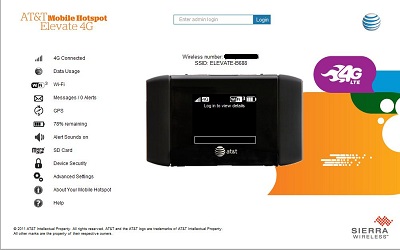
The menu from the ATT Elevate 4G
It was a simple process using an online form to obtain the device from ATT, but it took multiple calls to customer service to get the domestic and roaming services enabled. Getting international data roaming enabled was particularly vexing, as multiple customer service representatives did not seem to understand how to get these features working. A critical step was getting transferred to the international data desk.
We never could get it to connect on the first trip we took it on to India, Nepal, Thailand and Japan. Before traveling to the Caribbean, where the data plan covered several of the islands we were visiting, we activated an international prepaid data package. We had more luck in the Caribbean, but results were still mixed. Generally speaking, each location either worked or it did not, and no amount of playing around with settings made a difference.
Still it was exciting to be offshore in Saint Barths with WiFi access at 4G speeds for all our devices thanks to the Elevate 4G. Several improvements would enhance the service. For example, the possibility of sharing the microSD card out to the wireless devices and more consistent roaming. At the same time, I find it worthwhile to keep the data connection separate from the gadgets and be able to upgrade the data network independently in the future.
Photos: ATT.com, Simon & Baker Travel Review
by Editor | Apr 18, 2011 | Luxury Travel, Products
Article and photos by Joachim Castellano
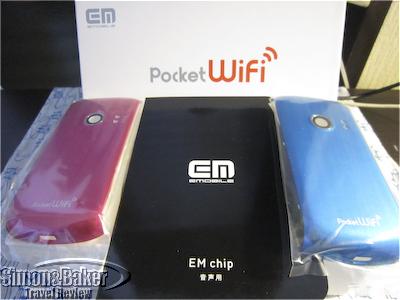
The Emobile Pocket WiFi-S package and covers
The Emobile Pocket WiFi-S (model number S31-HW) is a versatile Android-enabled smartphone that stands out thanks to a superb feature: with a touch of a button the user can create a personal Wi-Fi hotspot. In Japan, the only place where it was available when I tested it for 42 days, locating public Wi-Fi can be very difficult. Having my own Wi-Fi means I never have to worry about finding a wireless network that connects with my laptop, iPad, or gaming device. I can connect up to five different gadgets simultaneously.
In practice the wireless performance of this 105 gram phone manufactured by Huawei Technologies of China and distributed by Emobile of Japan wasn’t as fast as the Emobile’s Wi-Fi only Pocket WiFi (D25-HW) model. At times, the plastic and glass Pocket WiFi-S’ speed noticeably struggled in the slow lane; that was likely when Emobile’s network traffic was particularly clogged.
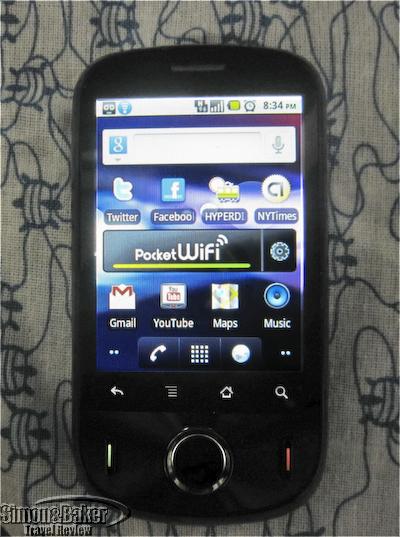
The front of the Emobile Pocket WiFi-S
What I lost in speed, however, I gained with the versatility of a full-fledged smartphone. I was able to make phone calls, browse the web, send and receive email, consume media, and navigate with GPS just like with any standard smartphone on the market. Also, because it runs Google’s Android mobile operating system, I was able to download apps from the Android App Market. For example, train schedule and route apps like Hyperdia or Jorudan helped me navigate the labyrinth of Japanese rail. I downloaded one of these apps and recycled the wrinkling pocket rail guide I had been toting around.
The smartphone, 54.8 × 104 × 13.5 millimeters in size, ran Google’s Android 2.2 operating system with a menu system in English and Japanese. The wireless (b/g) WiFi hotspot was capable of connecting up to five devices at HSPA 7.2Mbps down/5.8Mbps up connection speeds. It included a rear-facing 3.2 megapixel photo and video camera, 2.9 inch touchscreen, built-in speaker, 3.5 mm audio jack, Bluetooth 2.1, and had 512MB of memory with expandable memory through a microSD slot.
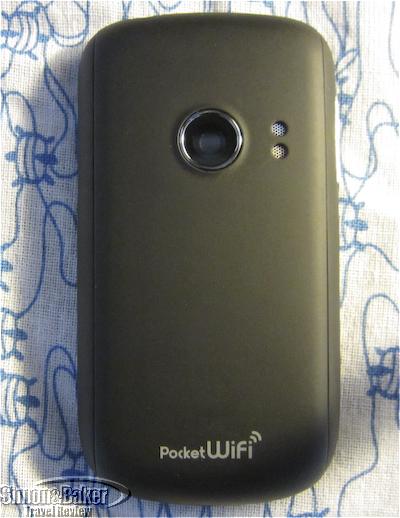
The back of the Emobile Pocket WiFi-S
The phone I tested had a battery length of five hours of talk time, four hours of standard usage, and 240 hours of standby. It came with one battery pack, AC adaptor, USB cable, microSD card, and three color covers, black, blue, and pink. The retail price was 19,800 Japanese yen ($235) as part of a two year contract, and phone and data plan costing about 8,000 Japanese yen ($95) per month.
While not as slick and graceful as its fruity and shiny rival, the Pocket WiFi-S does have that personal Wi-Fi network trick up its sleeve.
by Editor | Jun 21, 2010 | New Articles, Products
Article and photograph by Josette King
I have long nurtured the fantasy of one perfectly versatile suitcase that would take me across the country or to the far reaches of the planet, preferably in carry-on only travel mode. When the complexity and length of the itinerary required more, it would expand just enough to carry all my travel necessities to my primary destination, then gracefully retract to its carry-on purpose for shorter side trips. And of course, it would hold much more than a carry-on bag ever could, and take all the abuse a memorable trip can dish out without adverse effects.
Enter my new Briggs & Riley Baseline 20” Carry-On Upright, an expandable wide body suitcase. Sized to meet most major airlines carry-on requirements for domestic as well as international travel, it also featured a zipped expansion gusset that extended its capacity by almost 25 percent to become a checked bag able to carry the necessities of an eight-week, winter into spring European trip across the Atlantic. Its interior was a masterpiece of thoughtful design. Wide enough to accommodate side-by-side two neat stacks of sweaters and shirts, it also had a small zipped garment bag compartment fitted in the case’s lid.
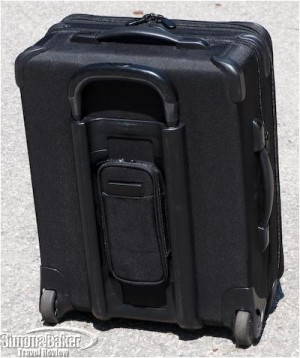
Briggs and Riley Carry On
Its sturdy construction allowed it to withstand less than ideal traveling conditions. It was dragged across the cobblestones of Bruges in a downpour (yes, its ballistic nylon exterior is water repellent), and up one flight of stairs in the Paris metro. It even became a handy stool when I found myself traveling in the corridor of a German high-speed train. Click here to read an article about the Briggs & Riley Baseline 20” Carry-On Upright.
by Editor | Nov 16, 2009 | Luxury Travel, Products
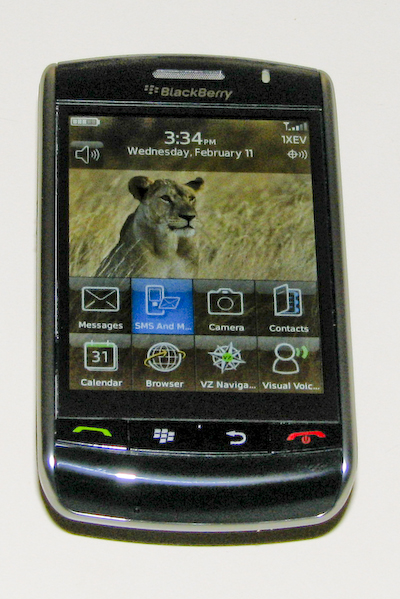
Verizon Blackberry Storm
In today’s rapidly evolving marketplace of smart phones, the Blackberry Storm from Verizon raises the bar with several unique features. Its compact form fits comfortably in the hand or pocket with minimal external controls to mar its sleek solid feel and sleek design. With the screen lock enabled, the phone fit comfortably into a pocket with the need for a protective case.
The unit we tried had an 8GB mini-SD installed and came with an international plug package that was useful in Europe; no additional adapter was required to charge the phone in Germany. We tested the phone for several weeks in Colombia, South Africa, Botswana, the U.S. and in Europe (Germany and France). It worked perfectly as a cell phone and Internet access functioned everywhere we tried it. It seemed that the high speed 3G network was available most of the time.
From the first touch, it is clear that this is not an ordinary phone. The bright screen is eye catching with a solid glass surface that actually clicks when pressed. Combined with onscreen displays it creates a totally unique feedback system for the user. The tactile response allows much faster use of the touch screen because the fingers know how many times a particular item was pressed. With many other touch screens, the visual queues take a second to be processed.
Another great feature is the rotation of the display as the phone turns, which is enabled in every application. Some competing systems provide a similar response when the phone is turned, but most do not have it as deeply ingrained into every application as the Storm. For those users with large fingers, the sideways full screen keyboard was a real blessing.
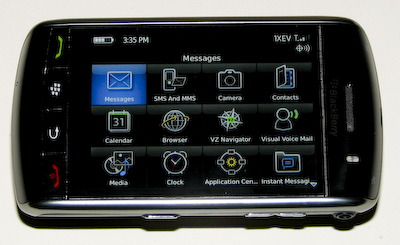
Verizon Blackberry Storm Horizontal
Web access was smooth and natural with excellent reproduction of most web pages on the tiny screen. A few quick finger motions allow for rapid navigation and scaling in an intuitive manner, and made browsing practical in spite of the lack of a keyboard. It was great having a fully functional browser always along to quickly look up an address or phone number.
Email setup was made easier by predefined wizards for common mail services, but even regular POP configuration was quickly accomplished. The built-in camera allowed us to send instant postcards to friends and family using email attachments. With a 3.2 Megapixel photo size, a built in image stabilizer and video capability, the Storm offers multiple options to capture the moment.
The application suite that came with the phone allowed download of movies and audio files for playback on the Storm. The video format produced a nice picture quality with practical volume on the speakers, although the application took quite a bit of time to convert to the format used on the phone. The software was Windows based and the install was straightforward.
Once installed and connected to the phone, audio, video and images could be loaded into the chip memory installed in the phone or extracted to backup the smartphone to the computer. We like the idea that the micro-SD memory capacity can grow with technology, a serious advantage over competitors with hard wired RAM for storage.
A favorite feature was the data modem which allowed the laptop to access the Internet through the smartphone high speed network access. Fair use rules apply and allow a liberal amount of network access when traveling. We had less success in Europe, it was trying to connect to the German parent company for Verizon, but just never quite got it working.
In summary, the Verizon Storm has a number of features that make it a serious contender for the Apple iPhone. With swappable memory cards and batteries, smaller size, improved photo and video capability, tactile feedback and fully integrated display rotation, the Blackberry Storm sets the bar higher and will attract business users interested in a highly functional international phone.























